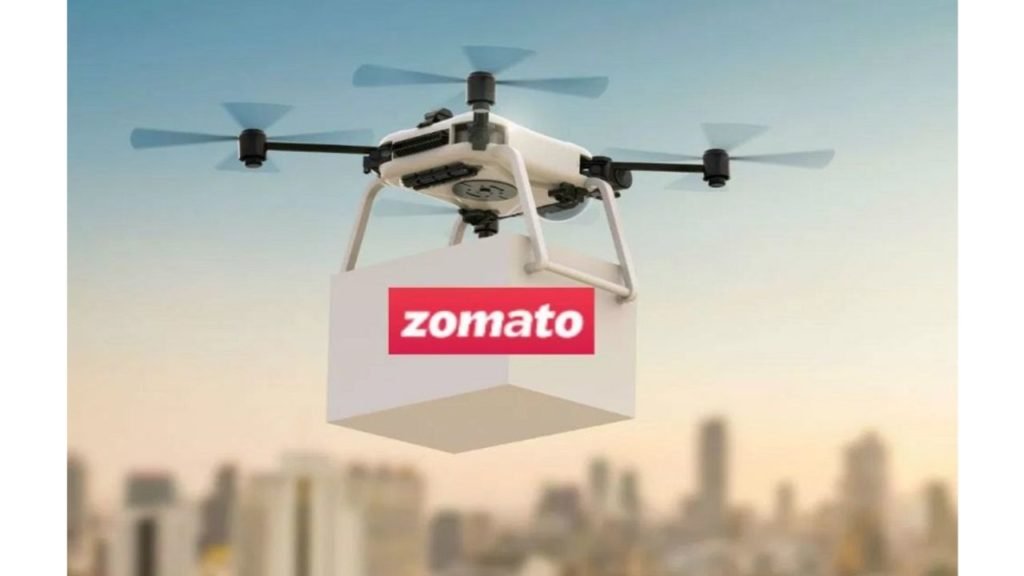Feeling spent after five days of toil and stress at work and in no mood to fix a meal? Don’t fuss. Simply reach for the phone and make a couple of swipes before tuning in to the next episode of your favourite TV show. Voilà! The dessert you’ve been craving for all week is at your doorstep soon enough. This is the technology that has given us so much of comfort in our life. But, what if there is more to that? What if the food that you have ordered will not only reach you but it will reach you as fast as the Flash!
In what could be the beginning of a future of aerial food delivery in India, foodtech unicorn Zomato has successfully tested its maiden drone delivery tech. This comes months after Zomato acquired TechEagle to develop a hub to hub delivery network powered by hybrid multi-rotor drones. The announcement was made by Deepinder Goyal, the founder, and CEO of Zomato.
A hybrid drone was used for the experiment which was able to cover a distance of 5 km in about ten minutes carrying a payload of 5 kgs. It covered the distance at a peak speed of 80 km per hour.
Zomato said that the average time taken by the biker fleet to deliver is 30.5 minutes. It added that the only way to reduce that time to 15 minutes is if the aerial route is taken. Given rapid urbanisation that is resulting in increased road congestion and pollution, Zomato believes that using drones for delivery would be a big game changer for metros as it will help scrape unnecessary traffic off the roads and direct it skyward. Founder and CEO Deepinder Goyal said that they have been working towards building sustainable and safe delivery tech and with their first successful test, food delivery by drones is no longer a pipe dream.
In the first iteration of food delivery via drones, they will pick up the food package from a restaurant hub (a dispatch station around a cluster of restaurants), and drop the package at a customer hub (a landing station close to dense communities), and comes back to the dispatch site using a mix of different and appropriate flight modes.
Although being fully automated, each drone is currently being tested with (remote) pilot supervision to ensure 100% safety. Over time, as the company collects more data, it might do away with pilot supervision.
However, the current regulations prohibit payload carriage on drones as well as drone operations outside visual line of sight. As per the notification issued by Director General of Civil Aviation (DGCA) on 13 May 2019, interested organisations have been asked to submit an Expression of Interest (EOI) to the DGCA for conducting experimental Beyond Visual Line of Sight operations (BVLOS) of Remotely Piloted Aircraft Systems (RPAS)/Unmanned Aircraft Systems (UAS). However, the government had said that the norms will be evolved with time as and when companies are able to exhibit newer technologies.
Keeping in line with this, the company has said that it is forming a consortium to carry out experimental operations of drones beyond line of sight as per the DGCA’s programme for conducting such trial . Zomato also stated that its drones have built-in sensors and an onboard computer to sense and avoid static and dynamic obstacles. So, yes, the drones are enabled for autonomous flights. Apparently, the drones are also capable of taking off vertically like a helicopter and then transiting to an airplane mode to cover the distance. And once it’s ready to land, the drone will switch back to helicopter mode. Pretty neat!
The company has said that the tech is ready and that drone delivery will be commonplace sooner or later. The CEO has also emphasized that they will have to keep regulatory hurdles and the government’s concerns in mind for this endeavour.
Not only Zomato, Amazon had also said earlier this month that self-piloted drones will be delivering packages to shoppers in the coming months. Amazon said its new drones use computer vision and machine learning to detect and avoid people or clotheslines in backyards when landing.
Well, let’s see if they manage to get everything together because we really can’t wait to get our food delivered on time.
